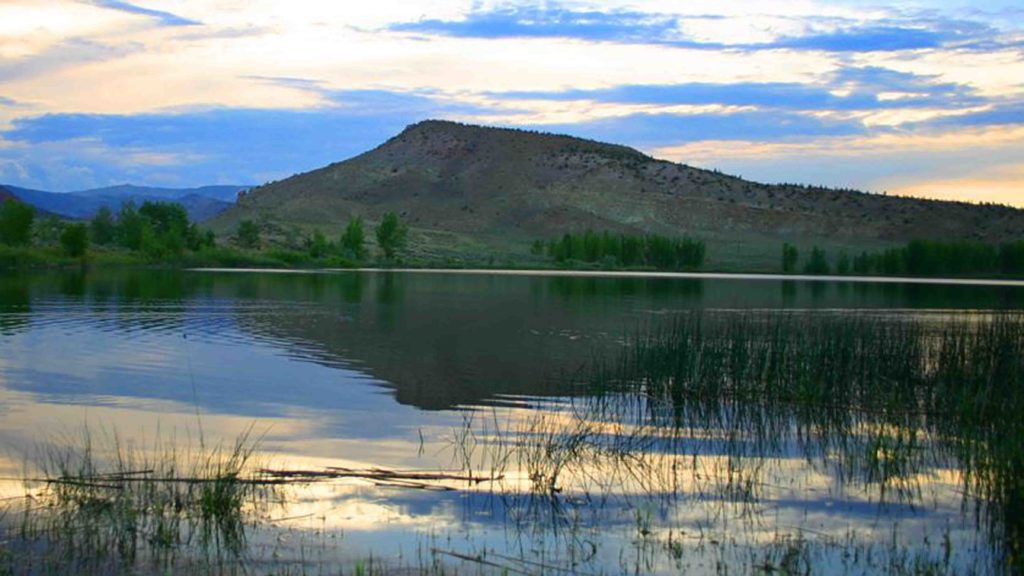Last week’s federal court decision placing gray wolves in most of the United States back under federal protection is often reported as a rollback of the Trump administration’s decision to delist wolves, yet few reports note that the Biden administration had supported and defended the decision made during Trump’s time in office.
It’s part of a trend in reporting that casts blame (or credit) either on Republican or Democratic administrations when it comes to decisions involving federal protections for endangered species, but history shows these are often false narratives.
The Bipartisan ESA
The early 1970s saw a wave of new laws favoring environmental protection in the United States, including passage of the Clean Water Act, Clean Air Act, National Environmental Policy Act, and creation of the Environmental Protection Agency, just to name a few.
In early 1972, it was Republican President Richard Nixon who requested that Congress pass a stronger law to protect endangered species of wildlife, and with overwhelming bipartisan support, the Endangered Species Act (ESA) sailed through Congress to be signed into law before the end of 1973.
The bill won unanimous support in the Senate and was soundly passed in the House by a vote of 390 in favor to 12 against. All three of Wyoming’s congressional delegation supported the bill, including U.S. Senators Cliff Hansen (Republican) and Gale McGee (Democrat), and Representative Teno Roncalio (Democrat).
Yes, back in those days, two of Wyoming’s three seats in Congress were held by members of the Democratic Party. Most members of Congress at that time supported what was viewed as a noble effort to protect endangered animals.
But it soon became clear that Congress did not understand how the ESA would actually work.
Tiny Fish Tests the ESA
The same year that Congress was working to pass the ESA, a scientist discovered a tiny fish in the Little Tennessee River. When the snail darter was listed as an endangered species in 1975, more than $78 million in public money that had already been spent in construction of Tennessee’s Tellico Dam when work was halted because the impoundment would disturb the habitat of now federally protected species.
The U.S. Supreme Court ruling in the TVA v Hill case became the landmark ESA case in its finding that the ESA required that endangered species be given highest priority over any other concerns, with no exceptions.
Tellico Fallout
The Tellico Dam controversy prompted Congress to amend the ESA in 1978 to allow federal agencies more flexibility in dealing with endangered species, including taking actions that would jeopardize a species if okayed by a Cabinet-level Endangered Species Committee.
This group would be informally called the “God Squad” for its ability to approve the extinction of a species if it found a project served a greater good. The 1978 ESA amendments passed with overwhelming support (93-4 in the Senate) in Congress, including support from Wyoming’s Congressional delegation, although by then Democratic Senator McGee had been replaced by Republican Senator Malcolm Wallop. The amendments were signed into law by Democratic President Jimmy Carter despite protests from within his administration.
Grayrocks
Meanwhile, another endangered species controversy had arisen. The debate over damming the Laramie River to create Grayrocks Reservoir was raging through Wyoming and Nebraska communities, the courts, and in Congress.
When the God Squad was scheduled to decide on whether creation of Wyoming’s Grayrocks should be exempted from the ESA requirement to protected endangered whooping cranes, “on the last frenzied day of Congress, retiring Rep. Teno Roncalio (D-Wyo.) got an amendment adopted that exempted Grayrocks from the act,” reported the Washington Post.

The Post reported on Roncalio’s arguments on the House floor: “Roncalio pleaded, “Do you want to send me back to Wyoming, after 10 years as your friend and colleague, to face 2,000 unemployed people in Wheatland on account of a totally unjustified thing like this, the Endangered Species Act?”
Roncalio’s amendment was later dropped, and the Endangered Species Committee was set to meet near the end of January 1979. At that January meeting, the God Squad issued two contrasting decisions: one declining to exempt the Tellico Dam from ESA protections for the snail darter in the Tennessee; and one in which the committee voted unanimously to exempt Grayrocks from ESA provisions that would protect whooping cranes in Wyoming.
Allow Water Projects or Forego ESA
Since the committee’s decision jeopardized the Tellico Dam, Congress then passed legislation specifically exempting the dam from ESA requirements, and the dam was completed in 1979. When President Carter signaled agreement to the Tellico exemption, the Washington Post reported: “Presidential adviser Stuart Eizenstat said Carter also feared that, if he vetoed the water bill, the Endangered Species Act, up for reauthorization, “would be chopped to ribbons with amendments exempting a whole variety of projects and species.
“There was a real concern that we could win the Tellico battle and lose the Endangered Species Act war,” he said.”
Ironically, the snail darter was removed from the list of federally protected species in 2021, its conservation deemed a success despite its loss of habitat to the Tellico Dam. In contrast, the whooping crane remains North America’s rarest bird, with its only self-sustaining wild population nesting in Canada’s Wood Buffalo National Park and migrating to winter along the Gulf Coast.
The 1990s Flipflops
Fast forward a few years to the early 1990s. There had been rumblings and debates over wolf recovery in the Northern Rockies for decades, with well-defined lines of support and opposition. In 1990, Republican Senator James McClure of Idaho proposed that Congress mandate the return of wolves to Yellowstone and Central Idaho but limiting protections outside those limited recovery zones.
The New York Times reported on Wyoming Republican Senator Alan K. Simpson’s reaction: ”If you can do it in a way which does not decimate the wildlife of Wyoming and a great part of the economy of Wyoming and part of the uniqueness of Wyoming, do it in a way where if the wolf gets outside the park it can be taken, i.e., shot and killed and then have a compensation fund for livestock owners who can prove depredation by that, then I’m ready to continue to talk.’’
Wyoming Republican Senator Malcolm Wallop testified at a Senate hearing: “I remain opposed to the reintroduction of wolves, and as a rancher, don’t want these animals in my state. However, I also know that wolves could arrive in Yellowstone by natural migration. If that premise is inevitable, I would prefer to have the opportunity to manage these predators on terms and conditions that the residents of my state could live with – and not be shackled by the onerous provisions of the Endangered Species Act.”
The Republican Deal
Although Congress didn’t adopt McClure’s original proposal, it did establish a Wolf Management Committee to develop a plan for wolf reintroduction.
That effort had a snowball effect, and by 1991, with President George H.W. Bush in the White House, and Democrats maintaining control of both houses of Congress, Congress directed the U.S. Fish & Wildlife Service to develop an environmental impact statement (EIS) assessing a proposal to reintroduce wolves to Yellowstone National Park and Central Idaho.
The EIS process was carried out during the Republican administration of President George H.W. Bush, with Manual Lujan, Jr. as Secretary of the Interior, and Wyoming’s own John Turner as FWS Director.
Republican Push
Turner pushed the proposal to transplant a limited number of wolves into Yellowstone and Idaho with the classification of non-essential, experimental status to allow more flexibility in wolf management.
In an editorial published in the Casper Star-Tribune early in 1991, Turner wrote of the “inescapable fact that wolves occur in increasing numbers and distribution in the Northern Rocky Mountain area,” and that those wolves would be treated as fully endangered. In effect, transplanting wolves into the area became the Republican compromise to allow for increased management flexibility.
As Turner’s U.S. Fish & Wildlife Service held public meetings and proceeded with the EIS, wolves kept showing up in the Yellowstone region, being filmed by a cinematographer, run over by vehicles, roped by a rancher, or shot by a hunter. The Republican administration and wolf advocates eager for the reintroduction found themselves on the same side, discounting the presence of wolves already in the region so that the reintroduction could move forward.
The stage had been set during the Bush administration, so when it left office in January 1993, it had cleared the way for the new Clinton administration to complete the job.
Democrats Carry the Crates
In 1994, Republicans swept both houses of Congress, and the official decision to conduct the reintroduction took place under Democratic President Bill Clinton, with Interior Secretary Bruce Babbitt, and FWS Director Mollie Beattie. Although these were the folks that were seen crating the wolves into Yellowstone National Park, the heavy lifting had been done in the Republican administration prior to their arrival.

Recovery Battles
By 2001, the initial wolf recovery goals had been met in the tri-state area of Wyoming, Idaho and Montana, triggering a review toward delisting. Several times during Republican President George W. Bush’s administration, FWS proposed to reduce protections or delist gray wolves in the Northern Rockies, but the administration was thwarted by federal court decisions. Irritated at the delay, Montana and Idaho sought to have wolf protections removed in their states, since much of the debate about delisting hinged on Wyoming’s dual status for wolves. While Wyoming continued its own battles, Congress removed federal protections for wolves in Idaho and Montana in 2011.
Obama delists, Court overturns, Trump Wins
In 2012, during the Democratic administration of President Barack Obama, FWS Director Dan Ashe approved a deal for Wyoming wolves to be removed from federal protection and allowing the state’s dual status of wolves as trophy game animals in northwestern Wyoming and an unprotected predator in the remainder of the state.
Two years later (in Sept 2014) a federal court reinstated federal protection for wolves in Wyoming. Both Obama’s FWS and the State of Wyoming filed appeal with a higher court, but it would be several years before the decision would be issued. Three months into Republican Donald J Trump’s presidency, the U.S. Court of Appeals overturned the lower court decision and returned wolf management to Wyoming. Wolves have remained delisted in Wyoming since then.
Conflicts Continue
While wolves in Wyoming, Idaho, and Montana remain under state management, last week’s court decision places wolves in parts of 44 states back under federal protection. The lawsuit was filed by wolf advocates during the Trump administration, but the decision was issued during the Biden administration.
Meanwhile, the fight over wolf protection in Wyoming and elsewhere continues – regardless of which political party is in the majority in the nation’s capital, or who is residing at the White House.
Wolf advocates have asked the Biden administration to consider placing wolves in the Northern Rockies (Wyoming, Idaho, and Montana) back under federal protection, and the Biden administration is now conducting a review to see if relisting pursuant to the ESA is justified.
Cat Urbigkit is an author and rancher who lives on the range in Sublette County, Wyoming. Her column, Range Writing, appears weekly in Cowboy State Daily.







